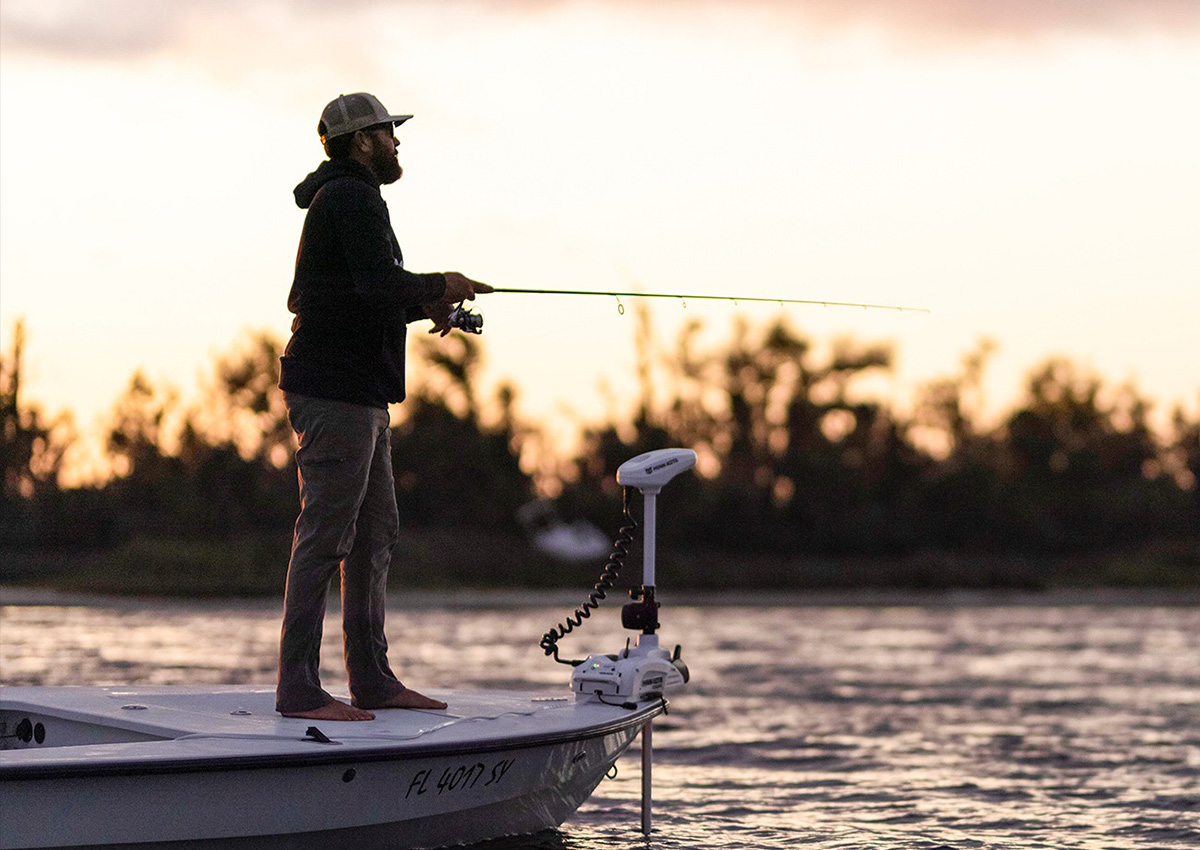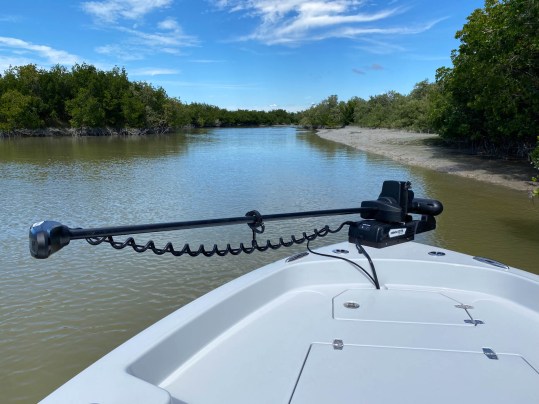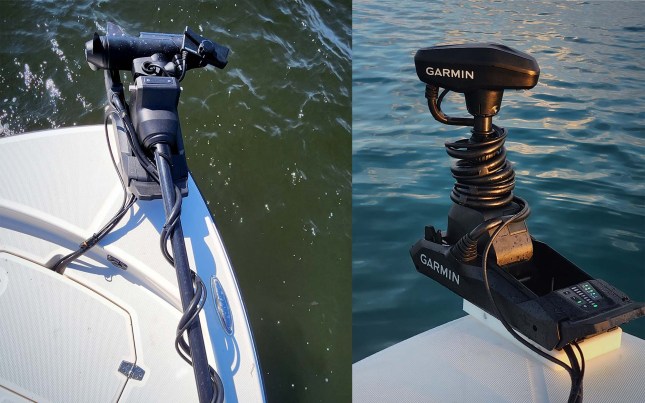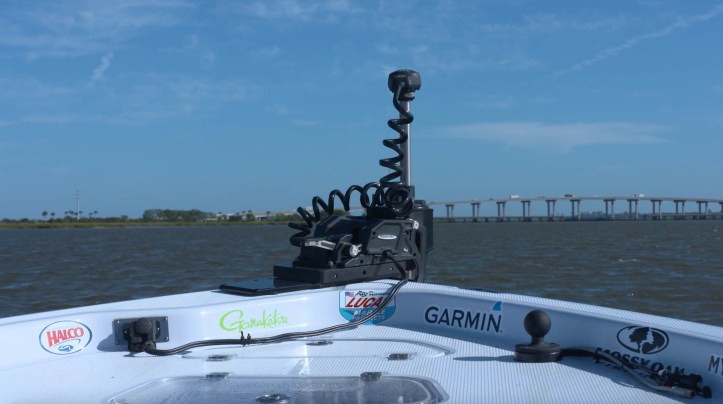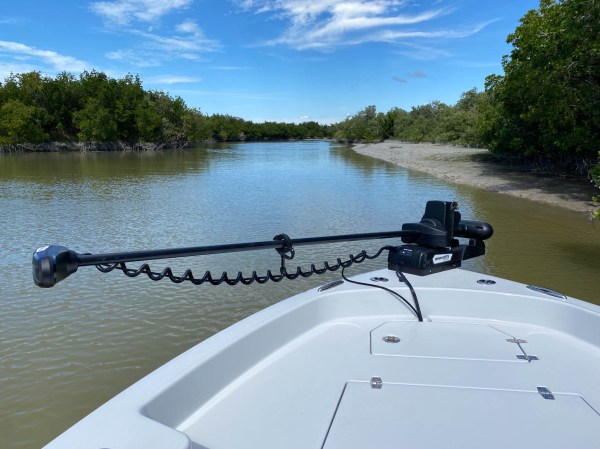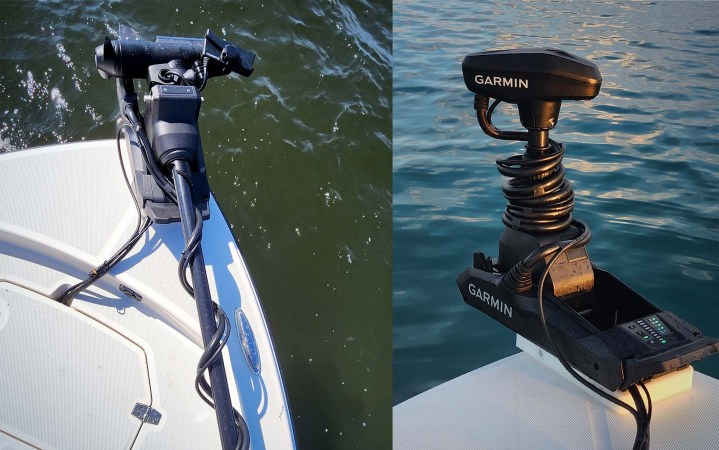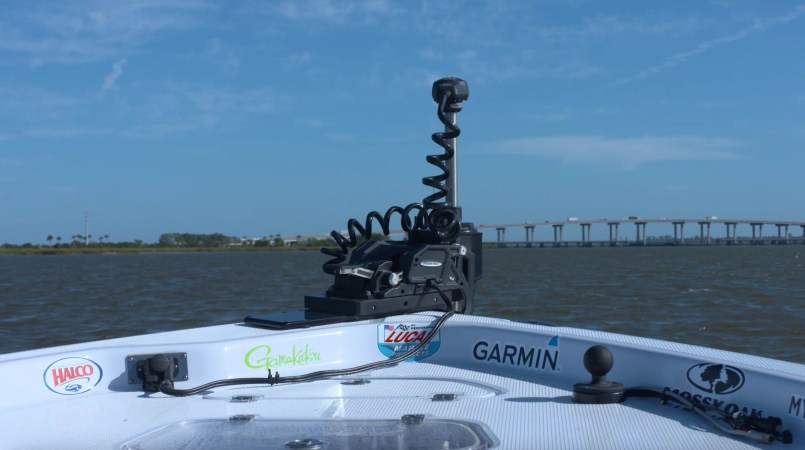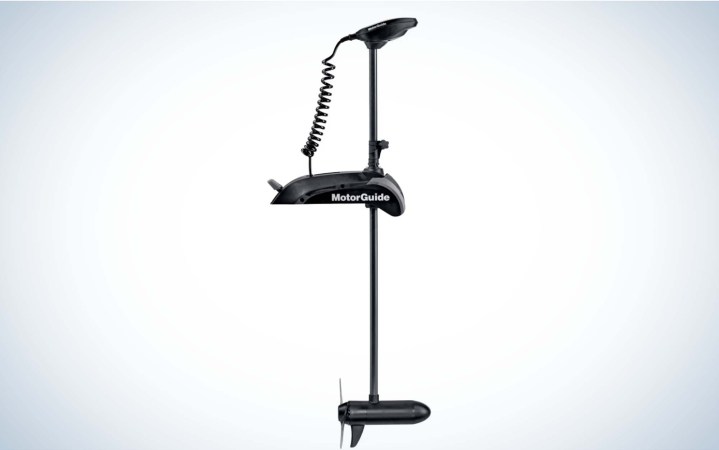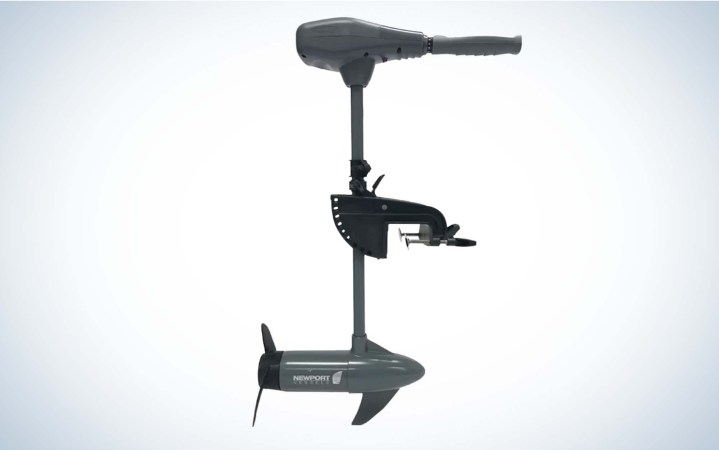We may earn revenue from the products available on this page and participate in affiliate programs. Learn More ›
O.G. Schmidt invented the electric trolling motor in 1934 when he attached the starter motor from a Model A Ford to a flexible shaft with a propeller on the end. A fanatical angler, Schmidt used the electric motor to maneuver his boat silently. Needless to say, the idea caught on, and trolling motors are now ubiquitous boat accessories.
Today’s saltwater trolling motors produce over 100 pounds of thrust with shaft lengths exceeding 90 inches to fit up to 40-foot-long offshore boats. As technology improves, saltwater trolling motors become more reliable and easier to use. And inexpensive models have many of the best features like GPS anchoring. There are a lot of advantages to a trolling motor from controlling a drift to holding your boat over structure, to silently cruising down a flat. But, you’ll need to find the best trolling motor for your boat and how you fish. I’ve broken down the top models across a range of prices and use cases to help you out.
- Best Overall: Minn Kota Riptide Instinct Quest
- Best for Large Boats: Garmin Force
- Best for Inshore: Power-Pole Move PV
- Best Budget: MotorGuide Xi5
- Best for Kayaks: Newport Vessels Kayak Series
How I Chose the Best Saltwater Trolling Motor
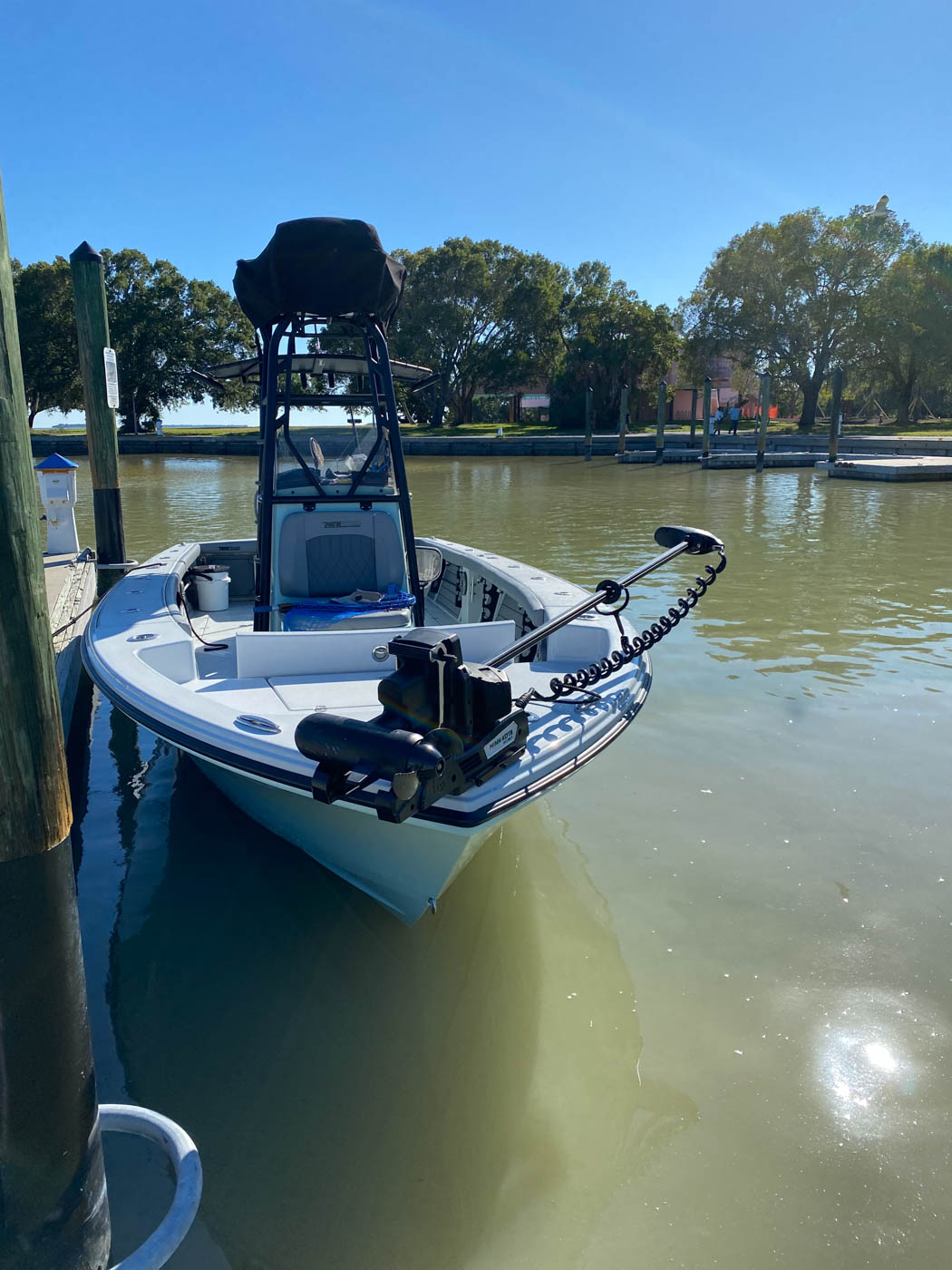
With so many great trolling motors on the market, how do you choose the best saltwater trolling motor? Saltwater anglers have pushed trolling motor companies to improve their products with larger, more powerful, and more durable models capable of withstanding the rigors of coastal fishing.
Saltwater fishing is diverse. One day, I’m wreck fishing 30 miles offshore, and the next day, I’m maneuvering my boat up a tidal creek. I need a trolling motor capable of performing in any conditions. Saltwater boats come in many sizes and shapes. There are trolling motors for a 30-foot sportfishing boat or a 16-foot flats skiff. There are also saltwater trolling motors capable of pushing a kayak miles from the launch.
In today’s market, there are more trolling motors with advanced features at a reasonable price. All of the models in this review feature an efficient brushless motor, corrosion-resistant shaft, and electronics. Most of the models are capable of wireless control and GPS connection. On the other end of the scale, a long list of bells and whistles, along with the most advanced design and materials, adds thousands of dollars to the price.
To choose the best saltwater trolling motor, I looked at models in each category with the most features at the best price. Intense competition to build better saltwater trolling motors encouraged several new brands and models to enter the race this year. That’s good for anglers looking to install a saltwater trolling motor. I can find a motor with the features and specs to fit my boat and how I fish.
The Best Saltwater Trolling Motors: Reviews and Recommendations
Best Overall: Minn Kota Riptide Instinct Quest
Key Features
- Power: 24, 36 volts
- Shaft: 60, 72, 87, or 100 inches
- Thrust: 90 or 115 pounds
Pros
- Auto deploy and stow
- Advanced corrosion protection
- Eco mode saves power
Cons
- Smaller models not available
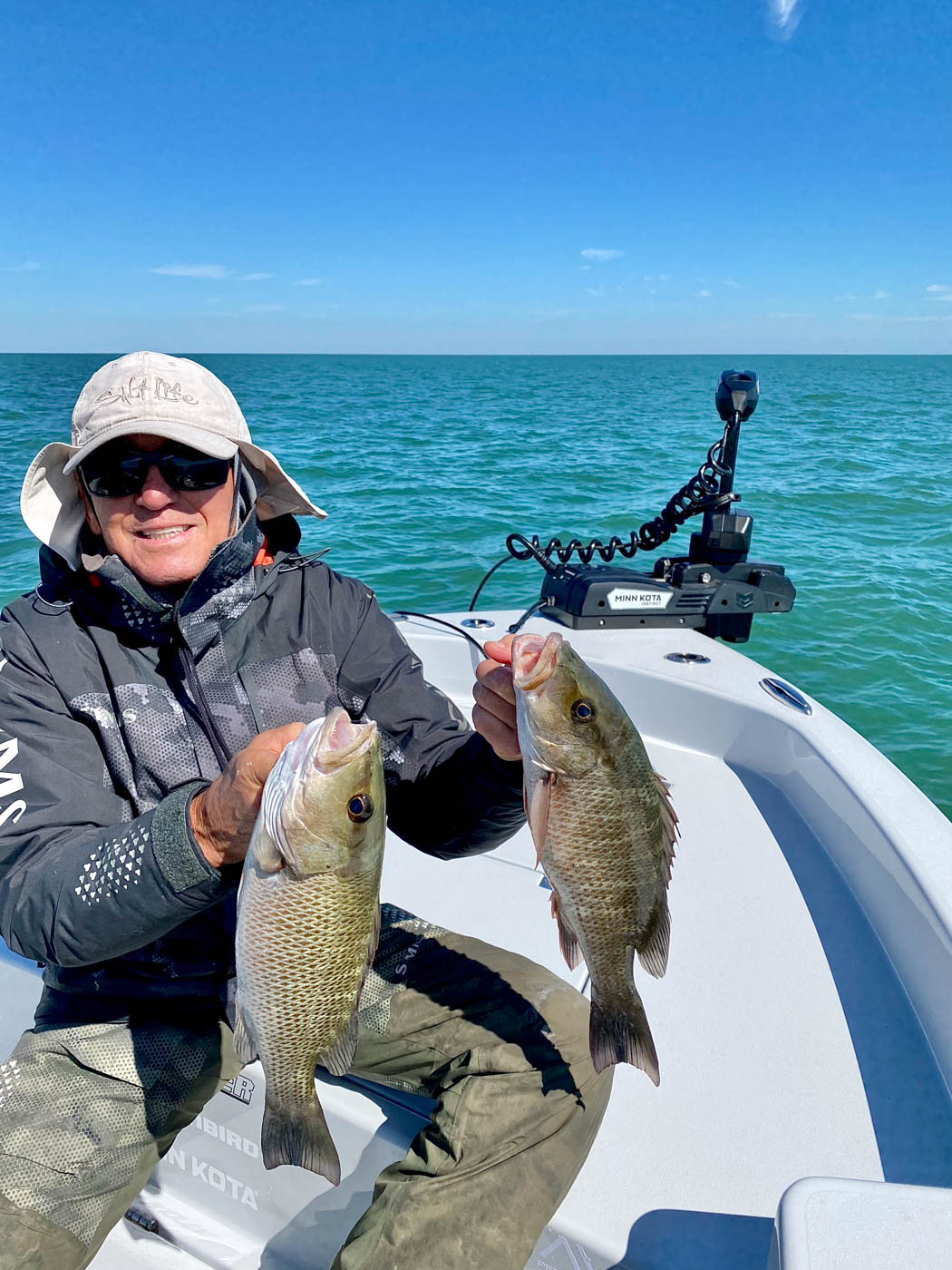
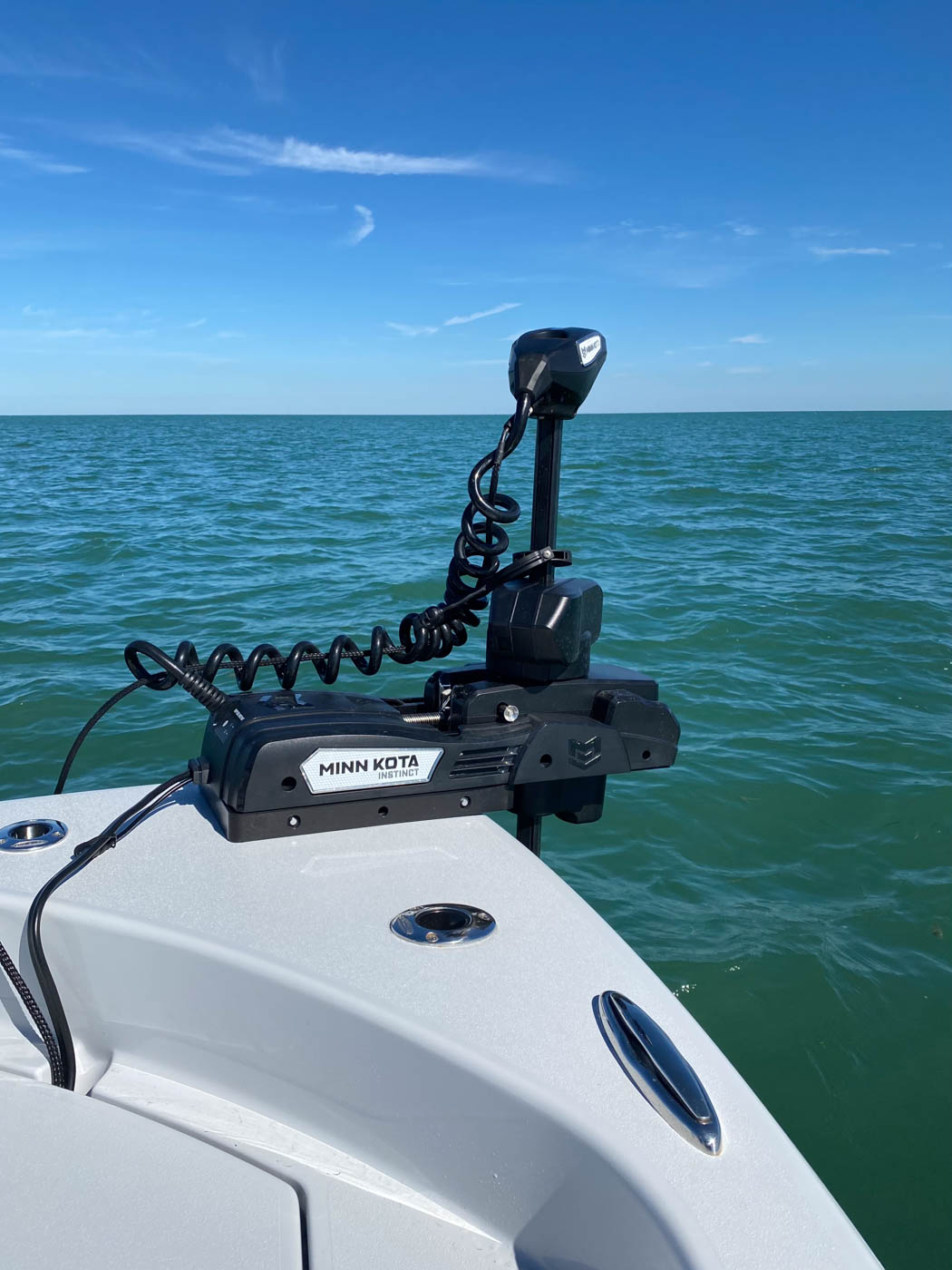
Completely redesigned for 2024, the new Riptide Instinct Quest represents the best Minn Kota has to offer. The first objective was to create a trolling motor better able to withstand harsh elements. Riding for hours on the bow of a 30-foot center console as it bashes through waves isn’t for weak-kneed trolling motors. The Quest’s shaft is reinforced with carbon fiber, and the lower unit is coated with anodized aluminum. A redesigned and reinforced mount keeps the Riptide Instinct Quest planted to the bow. The folks who invented Spot-Lock updated the GPS to be even more accurate under cloudy skies. To match the burly new trolling motors, the Instinct Quest comes in a choice of 24-volt with 90 pounds of thrust or 36 volt and 115 pounds of thrust. To fit the trend of large center consoles, the Quest shaft size is available up to 100 inches. The biggest challenge is providing enough power to use a trolling motor reliably with a large sportfishing boat. The Instinct Quest has an eco mode and digital maximizer to save power and a network connection to monitor motor functions and battery capacity. In fact, I can control the Quest Instinct with a wireless remote, smartphone app or Humminbird digital display. The icing on the cake, the Riptide Instinct Quest has auto stow and deploy feature. I just push a button, and the Quest pivot base does the rest.
Best for Large Boats: Garmin Force Kraken
Key Features
- Shaft: 63, 75, or 90 inches
- Thrust: 80 or 100 pounds
- Power: 24 volts or 36 volts
Pros
- Wireless network integration
- Multi-band GPS
- Remote control floats
Cons
- Still not tested on a large scale
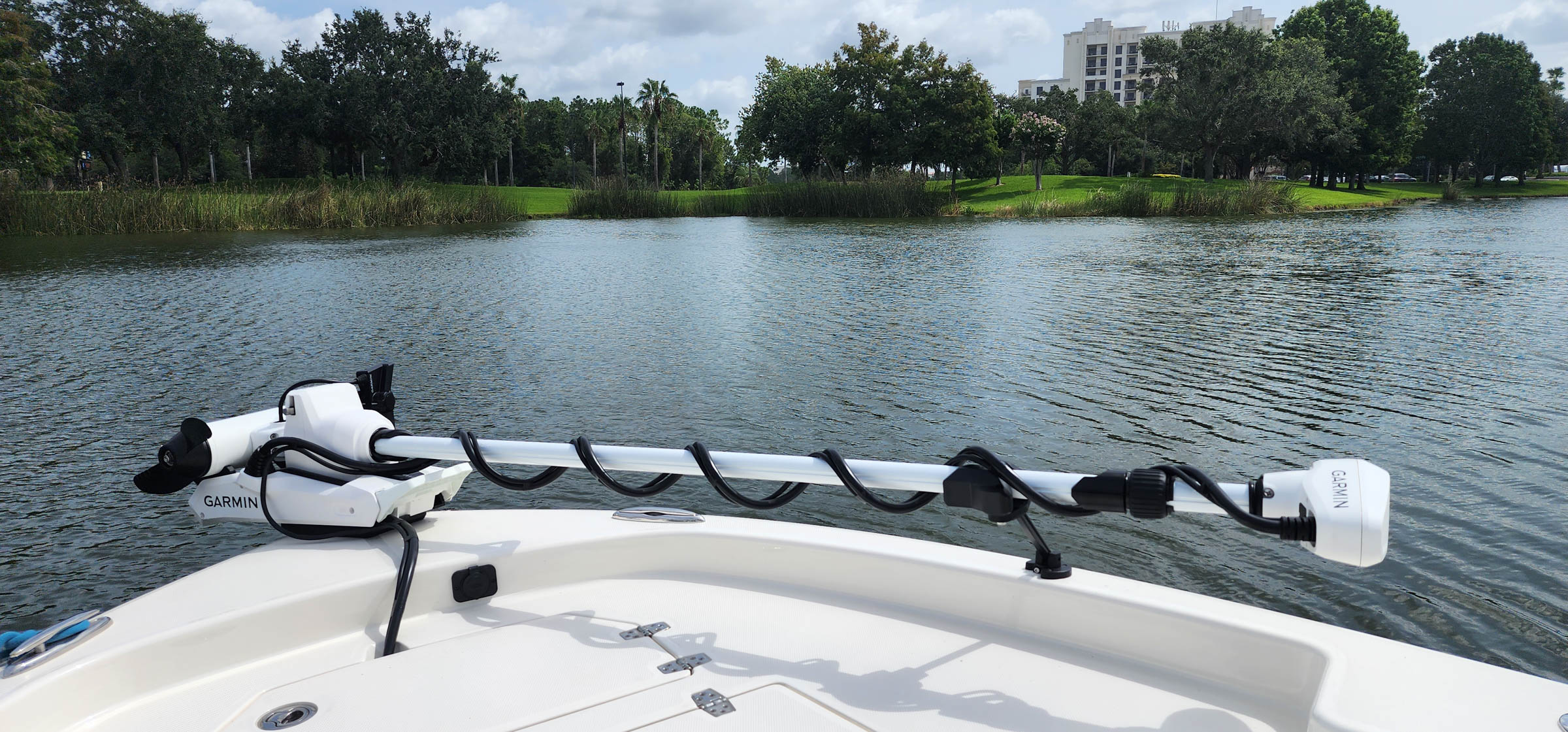
The biggest trend in trolling motors is integrating controls with a smart device, remote control, foot pedal or a multi-function display. Garmin’s Kraken allows users to connect to the most Garmin electronics. On my boat, I have Garmin GPS, so the Force Kraken offers wireless integration, allowing me to program a course on the GPS, and the Kraken will follow it. With more options for operating the trolling motor, I can quickly make corrections to maneuver my boat accurately. Garmin is famous for advanced GPS systems and the Kraken offers a multi-band antenna to update and stay on course quickly. Many anglers use their trolling motor’s lower-unit to house a Live Scope sonar transducer. Garmin makes it easy to route the transducer cable through the motor shaft for a clean, durable installation. My favorite feature is the pivot mount that takes up less space than a scissor-base. Unlike a freshwater bass boat, my 20-foot center console has a small bow platform. The pivot base allows more space on the bow for standing and fishing. Garmin is well known for the most advanced, reliable and versatile electronics packages and the new Force Kraken adds a matching trolling motor to the system.
Best for Inshore: Power-Pole Move PV
Key Features
- Power: 24 or 36 volts
- Shaft: 45, 52, 60, or 72 inches
- Thrust: 78 or 100 pounds
Pros
- Titanium Shaft
- Redundant systems
- Quick Release mount included
Cons
- Expensive
Power-Pole hit the ground running with their first trolling motor, the Move PV. The Power-Pole is already famous for their power anchor systems to quickly stop and hold the boat. The Move PV adds a trolling motor to maneuver the boat while fishing. The Move comes in two configurations: scissor mount or pivot mount. The pivot mount is most appropriate for saltwater boats with limited bow space. The Move has all the features of other premium trolling motors: GPS control, easy deployment and retrieval, intuitive controls, and a powerful brushless motor. What separates it is that Power-Pole designed the Move to be tougher, quieter and more efficient.
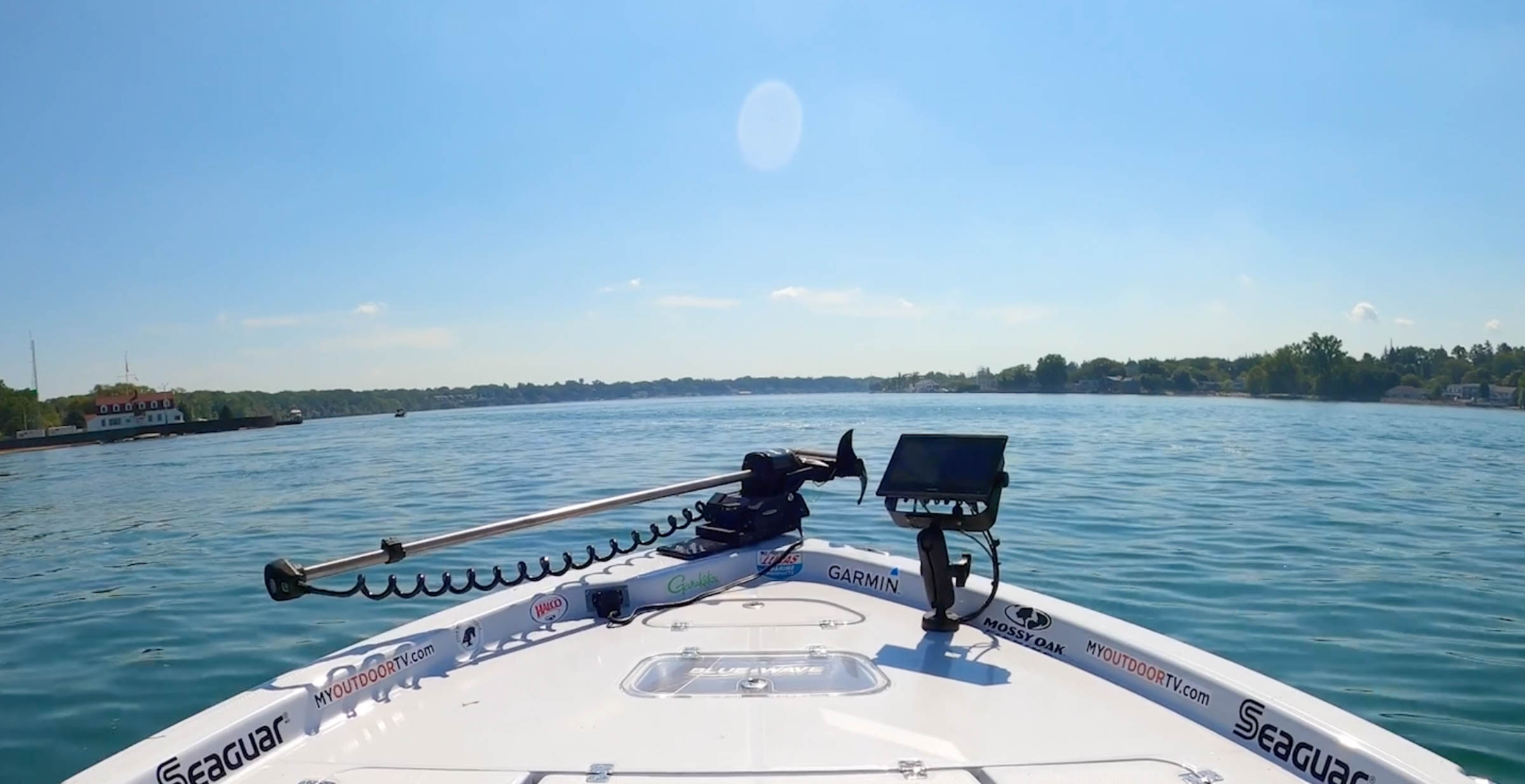
Its titanium shaft is light and durable. Power-Pole also designed fail safes in the control system. If a system stops working, there are backups to keep you fishing. The Move’s most noticeable feature isn’t noticeable. When the motor is running or the shaft is turning, the Move is nearly silent. I didn’t realize how much noise a trolling motor makes until I didn’t hear the Move.
And, according to Power-Pole, the Move’s brushless motor is 30 percent more efficient than other trolling motors. That means more time fishing on a full battery charge. One of my favorite features is the LED lights on the motor head that indicate when the motor is in anchor mode, prop on and navigation on. I can look at the motor and instantly know the status without fiddling with the remote. The Power-Pole smartphone application connects the Move to a Power-Pole anchor system for total boat control in the palm of my hand.
Best Budget: MotorGuide Xi5
Key Features
- Power: 12, 24, 36 volts
- Shaft: 48, 54, 60, or 72 inches
- Thrust: 55, 80, or 105 pounds
Pros
- Time-tested design
- Great value
- Wireless remote
Cons
- 72” longest shaft length
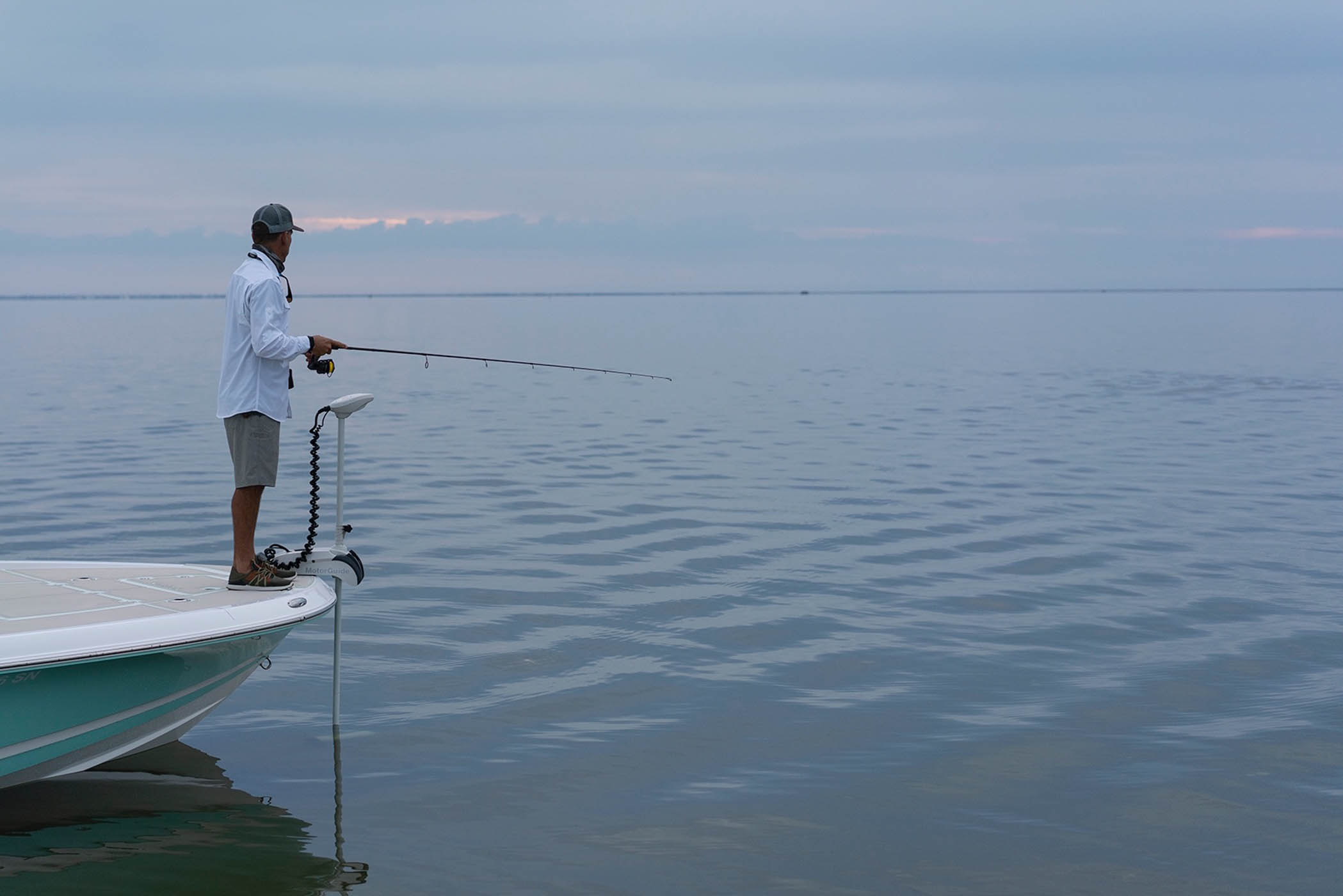
You can’t beat a classic, and the MotorGuide Xi5 Wireless Saltwater is one of the original saltwater trolling motors. Combining an accurate GPS with a time-tested design, the Xi5 kicked off the saltwater trolling motor revolution. The Xi5 is one of the most versatile motors I reviewed with models available from 48 inches to 72 inches and 12, 24, and 36 volts to fit anything from a skiff to a mid-size center console or bay boat. I’m always impressed with the Xi5’s performance. The motor is quick to respond to commands, so controlling the motor is seamless and intuitive. The same is true under GPS control, the motor locks onto a destination and responds instantly to wind and current to keep the boat on course. The first time I used the Xi5 in saltwater, I remember saying, “This is amazing.”
Best for Kayak: Newport Vessels Kayak Series
Key Features
- Power: 12 volts
- Shaft: 24 inches
- Thrust: 36 or 55 pounds
Pros
- Extendable handle
- LED battery indicator
- Extended cables
- Inexpensive
Cons
- Limited mounting/rigging options
- No GPS
- Not compatible with lithium-iron batteries
To extend range and increase confidence, many kayak anglers are adding an electric motor to the bow or stern of their kayaks. There are several options including electric outboards, bow-mount trolling motors and integrated trolling motors. Yet the simplest way to power your kayak is with a transom-mount trolling motor like the Newport Kayak Series or their NK180 and NK300 kits.
Newport Vessels Kayak Series motor uses two C-clamps to attach the motor to canoe or small skiff with a flat transom. There are several options to fit the motor to your kayak. Newport sells a bolt-on transom that fits the accessory inserts on many fishing kayaks. Or, use a gear-track mounted trolling motor base. The flat bar attaches to gear tracks along the stern well and holds the motor off the side of the kayak. This system keeps the trolling motor in easy reach but makes it a little harder to steer the kayak. Newport Vessels also produces batteries, battery boxes and cables to complete the package.
Unlike an electric outboard, which requires foot pedal-controlled steering, a transom mount motor is operated with a tiller. Turn the tiller handle to change direction or increase speed, the Kayak Trolling Motor even goes in reverse. The nice thing about a transom mount trolling motor is it is quick and easy to install and remove between trips. To run all day, the simple, lightweight motor only requires a 12-volt battery with at least 50 amp hours. Unfortunately, the NV Kayak Series doesn’t have GPS or a network interface, but at only $200 you get a lot of value with the simple kayak motor.
How to Choose a Saltwater Trolling Motor
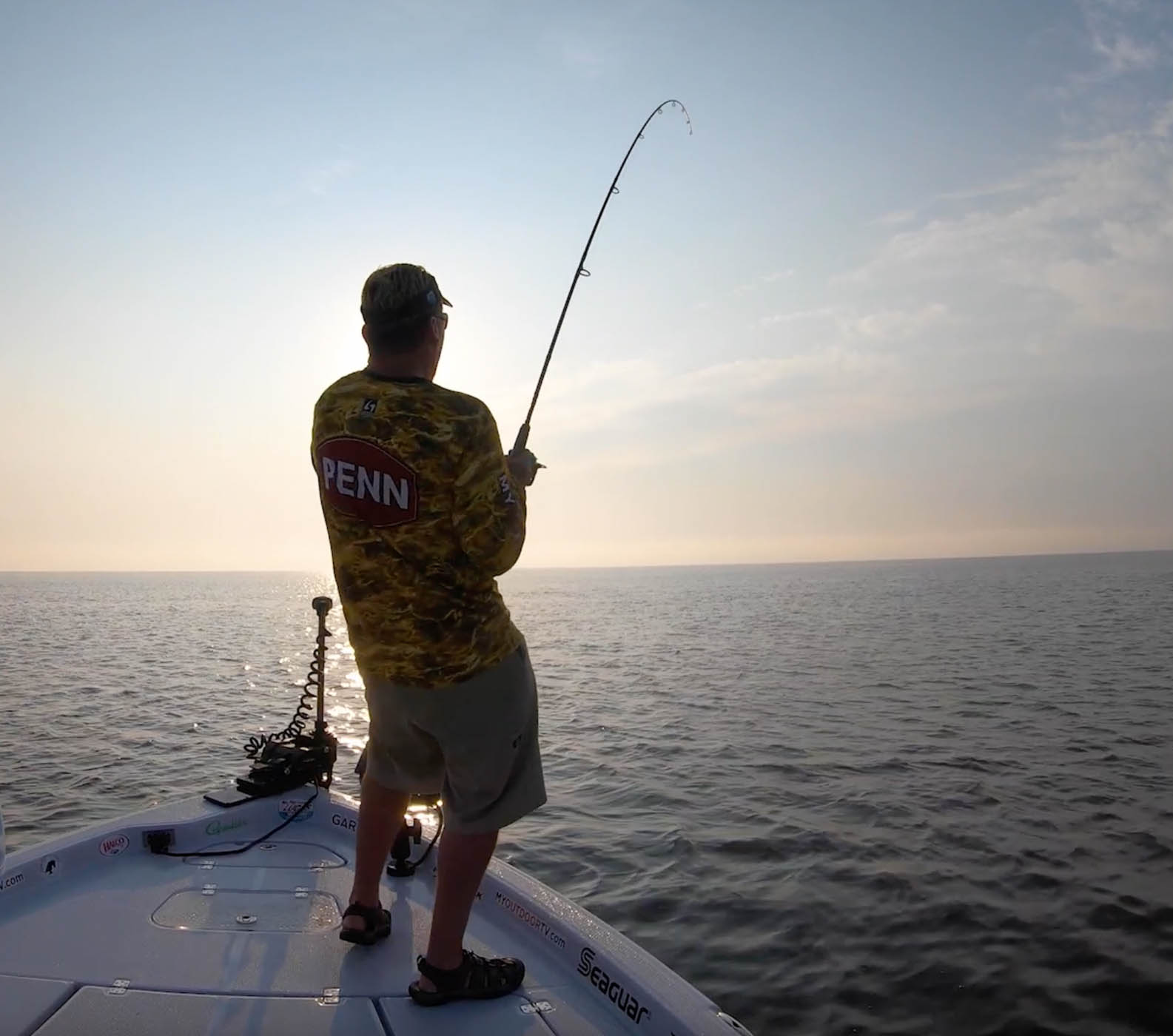
With so many great choices for saltwater trolling motors, it’s hard to choose the best. But, consider the size of your boat and how you fish to narrow down the choices. Then look at the price tag and pick the motor that best fits your budget.
Saltwater Trolling Motor Size
The first consideration is the size and configuration of the boat. Measuring the distance between the bow cap and the water will determine the trolling motor’s shaft length. To keep the propeller below the water, especially in rough seas, match the shaft length to the boat size. This formula changes from manufacturer and model, so read their instructions before you purchase the trolling motor.
Thrust
The next question is how much thrust? Trolling motor power is measured by pounds of thrust. A motor with higher thrust has more torque and speed. Obviously, a larger boat requires more thrust, but smaller trolling motors are available in different levels of thrust. You can purchase a trolling motor with a 90-inch shaft appropriate for a 25-foot boat, with 80 or 100 pounds of thrust. The 80-pound thrust motor would be better for inshore fishing, and the 100-pound model will have more power for heavy waves and currents found in open water. Thrust also affects battery requirements.
More thrust requires more power. A motor with 50 pounds of thrust is powered by a 12-volt battery. On the other end of the scale, a large boat with a motor pushing 100 pounds of thrust takes 36 volts. That’s three batteries in addition to the batteries for the outboard motor. More batteries not only take up more space and weight capacity, but they require a complex system for charging and connecting the batteries.
Mounts
Another consideration involves the space available for mounting the battery. Measure the bow for the trolling motor base. Saltwater trolling motors use a smaller pivot base that takes up less space but isn’t as robust as a scissor base. Bay boats with a large open casting platform in the bow can accommodate a scissor base. Other boats, with less space, are better matched to a pivot base.
Price
Once you determine size and power, the final consideration is price. There are great trolling motors in all categories at all price levels. The price difference comes from features and construction. Of course, a larger, more powerful trolling motor is more expensive than a smaller model, but even with similar size and power there are considerable price differences.
Saltwater trolling motors are cut from different fabric than their freshwater counterparts. Salt, sand, rough seas and strong currents put a trolling motor to the test. The best saltwater trolling motors feature corrosion- and impact-resistant materials and are designed to keep the motor running for years. For some anglers, though, this level of durability may be overkill.
Anchor Mode and Controls
Nearly all the saltwater trolling motors in our review feature brushless motors and GPS connectivity. Brushless motors use the latest technology to reduce power requirements and increase the motor’s lifespan. Connecting the motor with GPS allows the trolling motor to follow a pre-set course or hold the boat in one location.
Many trolling motors are paired with a wireless remote control. The angler can control the features and direction by pushing buttons on the remote. Anglers who expect to fish while operating the trolling motor opt for a model that can be paired with a wireless foot pedal.
Some trolling motors also allow the angler to control the motor and monitor systems with a smartphone or a multi-function display. To get the most out of the trolling motor, choose a brand that syncs with your electronics package.
Final Thoughts
Trolling motors are becoming standard equipment on saltwater fishing boats. Just like freshwater anglers, saltwater anglers realize the convenience and effectiveness of using a small electronic motor to maneuver their boat silently and precisely. With advancements in construction, design, efficiency, and control, trolling motors are up to the task of saltwater fishing. In the end, a saltwater trolling motor offers a huge advantage fishing inshore or offshore. With so many great trolling motors available, there is a saltwater trolling motor for every type of saltwater fishing.
